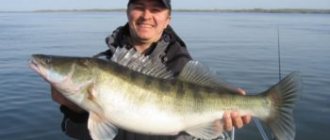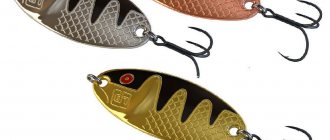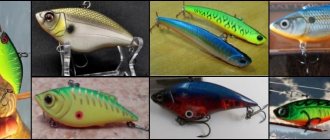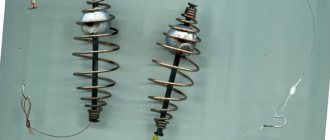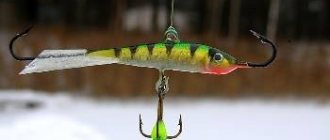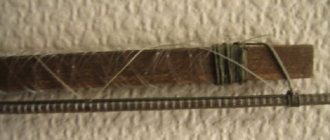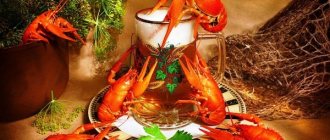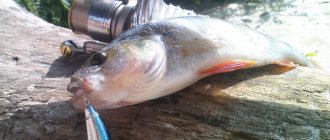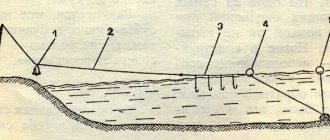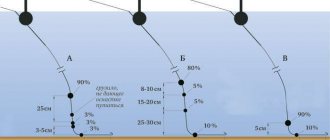What is a streamer and its difference from a front sight
A streamer is a bait for fly fishing, its appearance imitating fry of fish, frogs and tadpoles, and small mice. Designed to attract predatory fish.
The attachment consists of a hook with a long shank and the material from which the body, tail and wings of the streamer are made. Experienced fishermen use:
- rabbit fur - real or artificial;
- feathers of marabou, white stork, goose, chicken;
- synthetic materials.
The use of these elements for this type of bait is due to the fact that they hold a constant volume in the water and provide natural playfulness. Underwater, the vibration of the hairs resembles the natural behavior of fry.
Streamers made of synthetic fibers dry quickly in air and practically do not change volume in water. They do not work well in flows due to strong stretching under the influence of the flow. Attractive for perch and pike perch.
Feather streamers move smoothly and evenly. They are used in areas with a current, equipped with a head made of deer fur. They lure asp and saberfish.
Lures with a fur body are used in still water and in any current. They have less sail when casting, but the game of a fur streamer is the most natural. Attracts pike.
Realistic gameplay contributes to good catchability.
The streamer is universal; with the correct selection of material, fishing with it is effective both in areas with a current and in still water.
The streamer differs from other types of flies:
- complete external resemblance to small fish;
- behavior in water indistinguishable from the natural actions of fry and frogs;
- dull color.
The use of streamers has dispelled the myth that the larger the predator, the larger the size of the bait is required. You can catch quite large fish with a five-centimeter streamer.
Benefits of a streamer
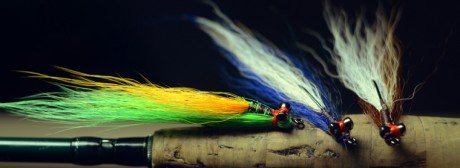
The main advantage of a streamer, compared to wobblers and spinners, is that it not only resembles a fry in appearance, but also perfectly reproduces the behavior of small fish. Since it is these feathers, hairs or the fur itself that are much more elastic than bait made of silicone, or even more so plastic. Therefore, if this bait is made with high quality, then in the water it simply transforms into a beautiful fry, which becomes very tempting for any predatory fish. It is also worth mentioning that the size of this bait rarely exceeds 5 centimeters, but this does not mean that a large predator will swim past. Therefore, the opinion that large fish require large bait in this situation should be considered incorrect. Another advantage is the ease of making a streamer at home.
Advantages and disadvantages of a streamer
Streamers have several advantages over other flies:
- ease;
- ease of knitting;
- if you get into a school, there is a chance of catching several fish at once;
- naturalness when guiding in shallow water areas;
- attract predatory fish during periods of low activity.
Lures also have their disadvantages:
- fur streamers absorb a lot of water and are then difficult to cast;
- the need for blank casts.
Making streamers from yarn and threads
If the phrase “yesterday, until I picked up a streamer in front of the popper, I didn’t take it at all” was said in a fishing store, it would be understood. If it is said by one of the spinners talking in a sewing supply store, it will be understandable only to them. And this is clear, it’s a matter of terminology. Another thing is unclear: what exactly are the spinners doing in this store? It's simple: they select materials for their homemade streamers. Not the materials and baits that we traditionally purchase in fishing stores, but, let’s say, alternatives to them. Alternative, because they are not the same, in the wrong place and at the wrong prices.
Fishing products are made for pleasure, and for pleasure you have to pay. The goods of the stores “For those who sew”, “Yarn”, “Handicraft”, “Fabrics” and others are for work, which is why the prices there are one or even two orders of magnitude lower. This is important, since the losses of spinning anglers who fish in strong places (and there are fish there) are often, as they say, off the charts. Therefore, the use of cheap materials and simple technologies in making streamers with your own hands is more than justified. The main thing is not the price and the absence of fly fishing departments in fishing stores in most populated areas.
The main thing is the scope for creativity, which is an important part of the fishing hobby of many fly fishermen and spinners who use streamers and other baits of their own production.
We must not forget about the characteristic behavior of fish under fishing pressure, when, due to indirect learning, it begins to refuse mass-used baits, but responds to something new, hitherto unknown to it. For those who are interested in this topic, I can offer the services of a guide and introduce some materials from which streamers can be made for successful spinning fishing.
The first thing you need to pay attention to is sewing and household thread. This is a very diverse material for making streamers and other baits. Viscose, nylon, nylon, polyester are the most common synthetic fibers from which thread can be made. The colors are also richly presented, and, in addition to the usual single-color ones, several types of multi-color threads are produced (photo 1). Streamers made from a bunch of threads (photo 2) are not only “breathable”, but also very flexible creatures, the properties of which in the water are no worse than streamers made from traditional fly fishing materials (from the hardest - deer tail hair to the most "playful" - marabou).
The advantage is that streamers of any length can be made from a bundle of threads, while from wool or marabou - no more than the length of the “bristles” or barbs of the feather themselves. We have already written in detail about the properties of streamers from a bundle of threads (in principle, wabiks) on how to make them without any devices for tying flies. In a similar way, transparent streamers are knitted from nylon fiber, which can be obtained by unbraiding any household cord or braid from gift bags with a straightened paper clip and combing with a large comb. And the braid of bows that decorate packs of Tian Zhen tea can be easily unwoven if you find the connecting thread and pull it (photo 3). The required amount of such braid in meters can be purchased at a sewing supply store.
Such streamers (photo 4) are distinguished by their pronounced transparency in water, and therefore any structure of the “filling” connected to the shank of the hook, for example, a contrasting color, shiny or segmented, is clearly visible through the body. Segmentation, marked with a waterproof marker (a fairly common technique in fly fishing), is also clearly visible against the background of the environment, even if its color is close to the color of the bait material.
Another advantage of this material is the unlimited length of the fibers and their flexibility, which allows the streamer, when mounted with a flat sinker, to imitate the movement of a “snake”. You don’t have to unravel the braid, but use it whole to make San Juan Worm type baits of different colors and sizes (Table 1). For such “worms” you can even use laces, the range of which is extremely diverse, as well as multi-colored strips of leather.
Photo 5 on the left (before the match) shows several types of braid, and on the right - strips of leather. If worms made of braid and laces are flexible and are better used for fishing in the style of "wacky" (with two tails), jigs or on lead rigs, then lures made of leather are more rigid, they are better suited for Drop Shot rigs (6" sanjuan in the photo "from a strip of leather is on the left). Metallized thread is also one of the most commonly used materials for flies and streamers. The diameter of the thread can be very different: from thin to voluminous, when it is more of a yarn and not a thread, and the amount of foil in the thread can also vary from one strand to a complete outer braid (photo 7). All this abundance is often denoted by one word - lurex.
Also interesting is lurex, woven from organic fiber (in photo 7 - a ball at the top right), which gives a rather varied play of color when moving. Lurex can be used as a separate bundle of threads, added to a bundle of regular thread or other fibers for wabik-type streamers, and also wrapped around the shank of a hook or any other material from which the body of the bait is formed. Most often, the amount of Lurex added to the design of the bait is determined by the fishing conditions: in good light, a small addition is enough - only to create reflections of reflected light; on the contrary, in cloudy weather, at depth, the use of more shiny baits, even those made entirely of Lurex, is justified (photo 8 ).
A material that is ready for use without pre-treatment is faux fur (polyester). Its undeniable advantages are the variety of lengths and colors, as well as the manufacturability of streamers, especially simple models. By visiting a couple of Fabric stores, you can purchase strips of faux fur (10 centimeters wide) and provide yourself with this material in a variety of colors with different pile lengths, for example, as in photo 9.
The simplest streamer (wabik) made of faux fur is made like this: we cut out a square of the backing (3 x 3, 4 x 4 mm, etc., depending on the expected thickness of the streamer), without damaging the pile, and fix the resulting bundle by the base to the forearm hook near the eye. We cut off the backing with excess pile and form the head of the streamer at this point, finishing the knitting with a knot and a drop of varnish. It is clear that the length of the entire structure depends on the length of the pile of the fur used.
A very technologically advanced material, varied in properties and colors, is wool for felting (also known as combed tape), which can be natural or synthetic (acrylic), thin and semi-fine, soft or hard, single-color or multi-color (photo 10). In some stores you can even purchase small, 10–15 gram “weights” of such wool.
From “felt felt” (one of the trade names for wool) you can make streamers, both the simplest ones, such as wabik, and quite complex ones, depending on your skill and imagination (photo 11). Acrylic felt is the thinnest and softest material (of the varieties of such wool), so the designs are flexible and quite playful. Acrylic colors are also the most vibrant. Of the natural fibers (which are generally stiffer than synthetics), the softest is Australian merino. In general, there is a wide choice. This allows you to select material for specific purposes.
For example, bright colors are good for shallow streamers, where the spectrum of illuminating light is still rich. Duller materials can be used for deep-sea streamers, where the spectrum of illuminating light is significantly depleted and the color of the bait itself is no longer of great importance. In the latter case, it is useful to add shiny materials (Lurex). The main thing, as in working with artificial fur, is not to overdo it with the “fat content”, because the thinner the streamer is, the more transparent and the more attractive it is for fish, and the required volume of the streamer will be retained in the water by the fibers of artificial fur and wool for felting. elasticity. The exception is black streamers for fishing at dusk, since the transparent design contrasts worse against the sky.
The segmentation of the streamer's body can be simulated by applying transverse stripes with a waterproof marker. The flexibility (and therefore playfulness) of streamers made of faux fur and felted wool is worse than that of the streamers presented above made from a bundle of threads or nylon fiber, so I use them where play is provided by other elements of equipment. I use small streamers made of faux fur and “felts” as pendants in tandems with the main bait, for example, 20–30 cm in front of a wobbler or popper (on a short leash or on a Palomar knot as in the Drop Shot installation), and larger streamers as independent lures in the Drop Shot rig.
Large streamers made of acrylic “felt” are more flexible, so they can be used as independent baits for jigs and lead rigs. Perhaps, yarn is traditionally used most widely for the manufacture of fishing lures and their parts (for example, to decorate the tee of a spinner with a bunch of hairs). Of the natural types of wool yarn, the most shaggy are angora (rabbit) and mohair (goat). The simplest flies for white fish can be made by winding the yarn quite tightly around the shank of the hook and fluffing the winding with linden fastener material. Silk yarn (mostly artificial, or natural mixed with synthetics), on the contrary, is smooth yarn (photo 12).
This fiber (in fly fishing - floss) is used to knit the body of flies, the main property of which is that when wet they acquire some transparency (but also darken greatly if the silk is colored). It is believed that silk flies with a shiny bead head (gold heads, pearl heads - in photo 18 there are two flies on the bottom left) have long been used in northern Italy for trout fishing in the rivers of the Alps and thanks to Roman Moser they gained popularity all over the world, giving rise to a special style of fly tying with a shiny head.
By the way, flies with a smooth body can be made from other materials, for example, from elastomeric thread for beading (photo 13), copper, lead or tin (solder) wire and other fairly soft materials that can be used to wrap the hook and then coat the material with varnish for nails of the desired color. The next type of yarn widely used for knitting streamers and flies is chenille yarn (chenille, plush, corduroy), which can also be natural or artificial (photo 14). This yarn can imitate the long body of a worm (San Juan Worm) or, when wound around the shank of a hook, create a voluminous body of a bait (such as Wooly Worm, Wooly Bugger).
The color range of such polyester yarn from the Dolphin brand is well represented in sewing stores. Of the many types of fancy yarn, you should pay attention to the one with which you can wrap the body of the bait with a “brush”, similar to that obtained by wrapping it with a feather. Such yarn is often sold in stores under the name “grass”, “samba”, “rumba”, etc. (photo 15). The “needles” sticking out from the main thread come in different lengths, straight and crimped. If long straight needles are suitable for forming a “brush”, then short crimped ones replace chenille in creating the streamer’s shaggy body. A very simple image of a caterpillar can be made from grass with short curls (Table 2).
At sewing supply stores, if you look hard enough, you can buy everything you need to make the famous Wooly Bugger streamer (detailed in last year's December issue of the magazine). Firstly, this requires a very flexible material for the tail, which is sold in the form of a lady's decoration - a boa. The most common type of boa is a “pigtail” with protruding marabou beards or a substitute - turkey down feather.
Boas are sold by the meter, so by purchasing 0.5 m of boas in the desired colors, you can provide yourself with this almost irreplaceable material for a long time. In large stores you can also find feathers themselves of different colors, sold in dozens (photo 16). This, by the way, is very economical, since in fly fishing stores both ligaments and marabou feathers cost two orders of magnitude more. However, for streamers of medium and small sizes, boas are more convenient; you just need to take and cut off a bunch of beards of the required length from the “pigtail”. By attaching the bun to the beginning of the hook bend, we get a full-fledged tail of the Wooly Bugger streamer.
The only (but insignificant, in my opinion) drawback is the uneven length of the marabou tuft beards cut from boas. Among the many descriptions of how to knit a Wooly Bugger streamer, there is a recommendation for just such a case. You need to firmly hold the tip of the tail between the thumb and forefinger of one hand, do the same with the other hand from the base and pull sharply. Photo 17a shows the streamer before, and photo 17b after such manipulation.
The body of the streamer is formed by winding a strip of large-pored foam rubber (also a good substitute for chenille), and the “brush” is made of grass. Flies with shiny bead heads have already been mentioned above. So, it is in craft stores that the choice of beads and beads is, one might say, unlimited. And not only in colors and sizes. The shape is also different: from spherical to cylindrical. Beads and beads can be used not only as heads of flies and streamers, but also for making eyes and segmented bodies of baits, simply by stringing beads onto a hook (photo 18). And that's not it.
It is known that fish are a big fan of caviar. Therefore, where (and when) she feeds on eggs, she can (and should) be offered a bait depicting several eggs in a “sac of mucus” (Table 3). If the fish is “tuned” to a certain type of eggs, it is better that the color and size of the eggs of the bait are close to those that it consumes. If at the moment caviar is not the main food, but only a delicacy (from time to time), then the bait may be less imitation.
After working with the materials presented in the article (and other, less commonly used) materials, you begin to guess the potential bait in the most seemingly unexpected places and products. You can say you fish without leaving the cash register. In the literal sense, because I saw the future knitted worm in a hair tie on the stand in front of the checkout in a grocery supermarket (photo 19).
Streamer fishing technique
There are two types of streamer fishing:
- fly fishing rod with some features;
- for spinning.
Fly fishing

The behavior of the bait must match the nature of the fish being caught. The streamer can drift slowly or actively move. For some predators, hearing the sound of the bait touching the water is enough to prepare for the attack of the prey.
It is difficult to control drift in areas with current, so fishermen try to cast the fly in such a way that the water carries it towards the predatory fish. Realistic play is achieved by periodically light tightening.
Spinning
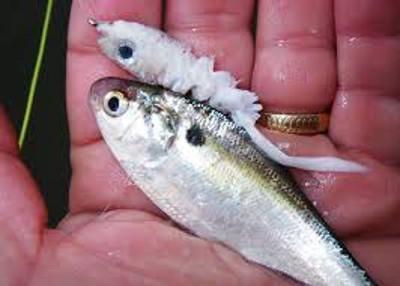
Casting is carried out as follows : swing the rod back and place the fly line on the water, giving it time to straighten. Then the rod rises into the air, the bait goes to the bottom and is pulled back by 5-7 turns of the reel. Then there is a pause, during which the nozzle is quickly released to the bottom again. The streamer is placed at the required distance with three or four idle casts. As a rule, the fish are caught on their own; no additional hooking is required.
The streamer is driven at the bottom or in the water column. There will be no problems with casting if the fish is a short distance from the coastline and you are fishing from a boat. When fishing from the shore, you need to use a weighted streamer to increase your casting distance.
Please note that under no circumstances should the cord be loosened; the tension should be constantly monitored, otherwise the fish may come off the hook feeling the slack.
The required speed and wiring tactics can only be selected experimentally, having tried several options.
Installation of gear
If you fish with a streamer as an independent bait, then it is better to use ultralight gear. Its weight is only 1–3 grams. This method of fishing is relevant on small rivers, when a predator can be caught at close range.
Tip: Fishing with a streamer is effective in the summer under branches overhanging the water, along steep banks, at local points.
Much more often, asps are caught with a beard, using the same long-range gear as for fishing with heavy spoons - a tall spinning rod, a powerful reel, and a sliding line. It is important to assemble the equipment correctly. The basic installation option is as follows:
- A leash up to 1.5 meters long is attached to the main line.
- At its end we attach a swivel with a fastener for a jig or other heavy bait.
- 30 cm from the end of the leash we make a loop 1–2 cm long using a figure eight knot.
- We knit the second loop in the same way, again retreating 30 cm. If desired, make a third after another 30 cm.
- We make short bends 10–15 cm long, at the ends of which we tie wabiks.
- We mount them to the leash using the “loop-to-loop” method.
We recommend reading: DIY hair rig for carp
That's it, a simple assembled beard. Its advantage is the absence of unnecessary elements and minimal cumbersomeness. During casting and movement in the water, the equipment does not get tangled, remaining attractive to the asp.
Some anglers attach double and triple swivels to the main leader to minimize line twist. This saves the equipment from possible tangling, but reduces its strength. Increases the requirements for each of its elements and the quality of knitting knots.
Choosing the right place for fishing with streamers

In winter and autumn, a good catch will be in small lakes, ditches, and small canals. Finding a suitable place is not difficult - river banks overgrown with vegetation, depressions, shallow estuaries.
In the summer, large bodies of water are catchy. It’s not so easy to find a good place here; you need to go out on the water in a boat. You need to hiccup fish on shallow edges, in coastal reed thickets, near stones, and on rifts.
The predatory fish chooses its ambush site carefully in order to hide securely and attack its food at the most opportune moment.
In bad weather, the fish do not respond well to surface baits. Toga streamer is carried to the desired depth, adjusting it with the tip of the rod.
How and where to fish with a streamer
If you are going to fish with a spinning rod, then definitely the best place for fishing with a weighted streamer will be overgrown lakes, places where spinners with lures cannot get to. Before you go to the pond, find out the fishing forecast for tomorrow. In such places it is better to use streamers protected from snagging with a special wire or fishing line. And the heavier weight helps to lower the nozzle lower - under a layer of water lilies and other surface vegetation. Moreover, if there are a lot of such thickets, don’t be alarmed, you can first throw the bait on the grass, then pull it into the water. In such thickets, it is better to carry out wiring in small jerks of approximately 30-40 cm, leaving a pause for a couple of seconds. In shallow water, the retrieve is carried out in longer jerks, and the pause time depends on the activity of the predator, and the more active the fish, the less time you leave the bait without moving.
In hot weather, it is better to use baits of dark colors: black, dark red, dark green. And in cool weather, when the sky is all overcast, it is better to use a streamer of bright colors: yellow, golden, bright orange, light green.
Features and DIY instructions for different types of fish
Asp
When fishing, streamers are used for asp, tied on hooks from 10 to 6 numbers. Catchy shades - white and red .
- Secure the hook in a vice and wrap the forend with mounting thread until it is rounded.
- Prepare a thread for dabbing - pearlescent fiber Crystal Flash .
- Step back 4-5 millimeters from the fore-end and wrap the rest of the thread with thread - this is the body of the bait.
- Make several turns of silver wire on top of the dabbing (the distance between them is up to 2 mm). Secure the end with a mounting thread.
- Fasten a bunch of white wool from the tail of a cow or goat to the ring. Its length should correspond to the size of the forend. This is a non-volumetric fender liner.
The necessary glow is obtained by fixing fibers with a pearlescent sheen. They are secured with thread over the wool.
- A tuft of faux white fur is attached above the fender liner, completely covering it. Several Crystal Flash .
- The white feather of a rooster or goose is combed against the natural direction of growth. The thin part is attached to the hook at the base of the wings, making a couple of turns with the thread and turning the fastener at the base again.
- The feather is raised perpendicular to the base and the dabbing thread is used to draw all the barbs of the material in one direction.
- The feather is made 5 times around the forend, reinforced with thread. The remains are cut off.
- They cut out another bunch of faux fur, slightly larger than the previous one, and fix it.
- Make a fender cover from synthetic fibers of gray color with shine. Trim excess threads with scissors.
- Form a head and glue it with varnish or glue.
At the end of the article there is a video about how this streamer is made.
Perch
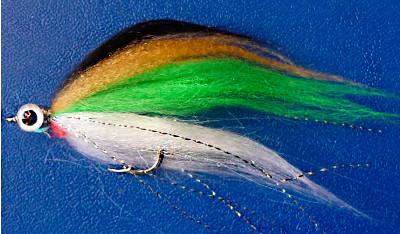
- Secure the hook in the holder and wind it with a brown or black assembly thread until it bends. It is necessary to weight the streamer with lead wire, turning it up to half the forend.
- Use a large red bead as a head.
- The tail is formed from the barbs of a red rooster feather.
- The body of the bait is made of black marabou feather. It is fixed with a thread from the tail to the head, and then wound around the fore-end.
- Make dubbing thread from red rabbit fur and secure it in place of the wing with thread. Make another part of the wing in the same way from black marabou feather. It is made one and a half turns.
To ensure that the wing barbs do not interfere, they are collected into a bundle with a cambric, which is put on the body of the fly through a thread guide.
Zander
To make a streamer for pike perch, a hook from 10 to 4 numbers is suitable.
Let's consider a simple version made of golden artificial thread.
- Secure the hook in a vice.
- Near the curve, tie a bunch of golden synthetic threads to the tip.
- Wrap the shank towards the eye of the hook.
- Fix the end and form a head, which should be opened with varnish.
- Dry the finished streamer with a hairdryer and slightly curl the heated golden antennae with a needle.
At first glance, it is an elementary streamer, but it showed excellent catchability in the summer.
Trout
The streamer is knitted on a medium-sized hook - from 12 to 10 numbers. Colors that attract fish: black , orange , light green . Bait for brook trout can be made from available materials, for example, from thin satin ribbons and a dust broom .
- Secure a hook in the holder, which will become the basis for the bait.
- Tear the black satin ribbon into fibers.
- Cut 2 bunches of orange and green from the panicle. Collect them into one.
- Thread a multi-colored strand through the ring of the hook, turn the tip down and wind it with thread or copper wire to make the head heavier.
- Trim off the excess with scissors - the fibers should be slightly longer than the bend of the forend.
- Tie black fibers from the ribbon near the head with a thread. Secure with thread.
When wet, such a streamer becomes long-range, and when it gets into water, it becomes voluminous.
Chekhon
Hooks - from 10 to 6 numbers. The colors of the bait are shades of gray , white , shiny fibers . In its feeding method, sabrefish is similar to asp; a streamer for catching it is made according to the same principle as for another representative of the carp family .
How to make a streamer with your own hands
As already mentioned, streamers can be made independently. There are no particular difficulties in this. You will need bird feathers (pigeons, ducks or chickens), animal wool (goats or sheep), fur (rabbit or squirrel), Lurex, woolen threads, foam rubber or New Year's "rain".
- take a scrap of wool, a bunch of feathers or a piece of fur and attach it to the hook so that the middle falls on the eye;
- fix the future bait with a nylon thread, wrap the free part of the feathers or wool towards the forearm;
- tie a double-folded base of a piece of fur or a bunch of feathers, forming a small thickening - the “head” of the fry;
- tie the thread in a knot, cut off the ends, comb the bait and apply waterproof glue to the thickening and knot;
- color the bait red, yellow or green.
But for the streamer to be truly useful, when making it, you should take into account the type of fish you are going to catch and wisely choose the hooks and color of the future bait.
- asp . To catch asp, streamers tied on hooks No. 6-10 are used. It’s good if the bait is painted white or red;
- perch _ In this case, you should take hooks No. 6-12. Recommended shades: light green, black, red, orange. The body of the fry can be made from marabou feathers, the head from a red bead, the tail from red rooster feathers;
- zander _ Streamers tied on hooks No. 4-10 made of artificial golden threads have the greatest catchability;
- trout . Hook numbers are 10-12. Favorite colors of trout are orange, light green, black. A streamer can be made from a simple synthetic dust brush or from thin satin ribbons;
- saberfish _ It is better to take hooks No. 6-10. Streamer color is shiny gray or white;
- pike . Experienced fishermen believe that catching pike with a streamer is a random occurrence. Whether you agree with this or not is up to you. One way or another, this cautious predator most often falls for perch flies.
As you can see, making a bait with your own hands is not difficult. Master the technique of fishing with a streamer if you have the desire - too. Apply the theoretical knowledge gained from this article in practice, and may luck accompany you always when you pick up a fishing rod!
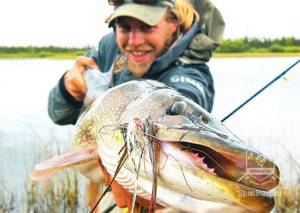
Tackle for catching asp with a beard
Today, the asp beard is increasingly used in spinning fishing, moving away from the usual fly fishing gear for this gear.
To catch asp with a beard, use a spinning
rod. The gear has small requirements, but they exist:
- rod The length of the “stick” should be 2.5-3 m;
- coil, an inertial model must be installed;
- main line with a cross section of 0.6 mm. It is necessary to use a fishing line with a diameter of 0.35-0.4 mm as a leash. Can be replaced with a cord;
- durable black hooks, both single and triple models are used;
- The sinker is taken weighing 32 g in the shape of a ball.
Buying a wabik and streamer
Not all fishermen are happy with homemade baits, since different breeds of predatory fish require gear with individual properties. Fishing departments , as well as numerous online stores that offer a wide variety of industrially manufactured streamers in a wide variety of price-quality ratios, successfully help solve this problem
Their main advantage is durability, achieved due to the quality of the materials used, as well as the variety of colors available, applied with waterproof paints. You can select and equip the gear according to your wishes and needs.
Features of using streamers
The wabik can also be used as an independent bait, but most often it is used in combination with other lures, spinners or wobblers.
For example, pike, pike perch, asp, perch. Their predatory instinct awakens - they seek to punish the stranger who dares to hunt in their habitat. And they attack even in cases where they are not hungry and would not pay much attention to ordinary bait.
In addition, the thickening that results when installing the wabik on the shank of the hook causes vibrations in the water during retrieval, which arouses additional interest of predators in this type of bait.
There are other advantages to fishing with streamers. For example, if the tackle successfully hits a school of sabrefish, you can often catch several fish in one cast.
Examples of wabiks made by fishermen:
How to properly catch an asp using a goatee
Catching an asp with a beard is effective only if you choose the right promising location. It's easy to find by sound. Sheresper hunts fry in a specific way - first he stuns them with strong blows of his tail, and then calmly grabs the small thing, which temporarily loses its orientation. In places with splashes on the river there is a high probability of finding a flock. By making an accurate cast to a promising place, the asp can attack the bait with its tail. Previously, a durable streamer was specially made so that the sting would not be exposed during an impact.
Fish hunt in the upper layers of water from spring to winter
When choosing a location, it is preferable to look at the south side. Casts are made in the upper layers of water in the warm season, but in the heat the predator sinks deeper (2-3 m). You can find asp from above in spring and autumn (during the warm periods of the seasons), as well as in summer. The best time for fishing in summer is morning and evening, when the predator goes hunting.
An important condition for successful fishing is camouflage, since upon detecting an angler, the fish will immediately move to a safe distance. The asp has good eyesight and notices a person from afar; any bait turns out to be ineffective. The noise will also prevent you from catching wary fish.
